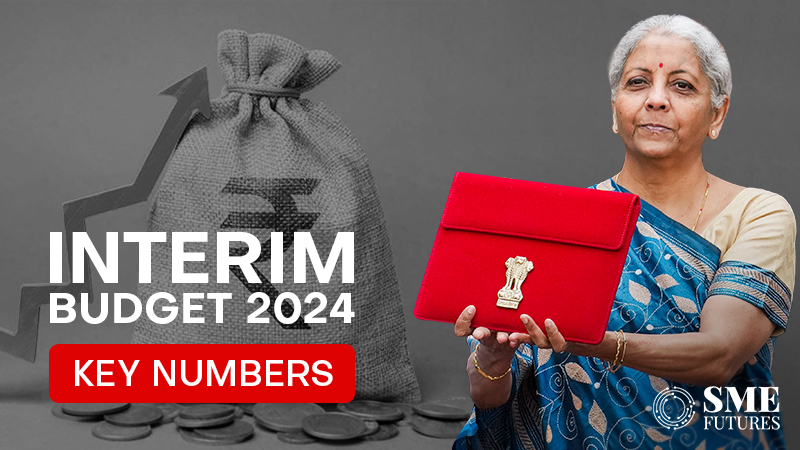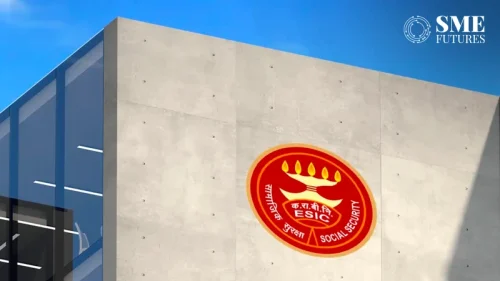The Interim Budget 2024 sets forth an ambitious vision for holistic development, steering India towards prosperity harmonised with nature, modern infrastructure, and inclusive opportunities. With a fiscal deficit target of 5.1 per cent along with a surge rooted in the principles of “Sabka Saath, Sabka Vikas, Sabka Vishwas,” the budget aspires to shape a developed India by 2047 through collective efforts, encapsulated in the spirit of ‘Sabka Prayas.’
Let’s have a look at some of the key numbers of this interim budget.
Interim budget at glance
Outlined in the interim budget, the estimated total receipts, excluding borrowings, stand at Rs 30.80 lakh crores, while total expenditures are projected at Rs 47.66 lakh crores. Tax receipts are anticipated to reach Rs 26.02 lakh crores. Despite the commitment to keep the fiscal deficit below 4.5 per cent by 2025-26, the 2024-25 fiscal deficit is estimated at 5.1 per cent of GDP.
In a strategic move, capital expenditure sees a historic allocation of Rs 11,11,111 crores, even as gross and net market borrowings are expected to be lower than the previous fiscal year at Rs 14.13 and Rs 11.75 lakh crores respectively.
Dr. Arun Singh, Global Chief Economist D&B, says, “Achieving a reduced fiscal deficit of 5.8 per cent in FY24 and projecting a fiscal deficit lower than anticipated at 5.1 percent is a positive credit outcome for India. This showcases the country’s capability to pursue a high-growth trajectory while adhering to the fiscal glide path. Despite committing to a lower fiscal deficit, the government has allocated a substantial capital expenditure of Rs 11.1 trillion (Rs 11,11,111 crores), marking a 50 per cent increase from FY23.”
Now let’s look at where the government is making money and where it spends it.
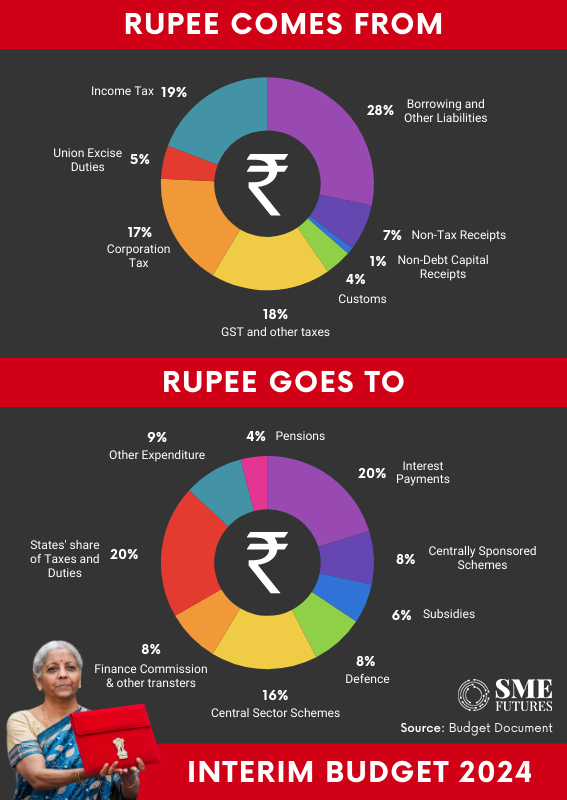
People-centric inclusive development
This budget underscores significant strides in physical, digital, and social infrastructure, emphasising the promotion of digital public infrastructure and the formalisation of the financial sector.
Proactive measures for inflation management and widespread participation in economic growth are highlighted, with Direct Benefit Transfer saving ₹2.7 lakh crores and lifting 25 crore people out of multidimensional poverty in the past decade.
Also, credit assistance to 78 lakh street vendors under PM-SVANidhi has significantly impacted their lives.
Once again, defence takes lion’s share
The government has raised the defence budget to ₹6.21 lakh crores for the fiscal year 2024-25, up from last year’s allocation of ₹5.94 lakh crores. The FM, during the presentation of the interim budget, earmarked ₹1.72 lakh crores for the military’s capital expenditure, primarily dedicated to acquiring new weapons, aircraft, warships, and other military hardware.
This marks an increase from the budgetary allocation of ₹1.62 lakh crores for capital outlay in the fiscal year 2023-24. Additionally, the FM talked about launching a new scheme aimed at bolstering deep-tech technologies for defence purposes, with the goal of expediting ‘Atmanirbharta’ or self-reliance in this critical sector.
Defence stakeholder, Sandeep Shah, Co-Founder & MD at Optimized Electrotech says, “This budget is not merely a financial plan; it’s a small step towards a comprehensive modification of the defence sector, heralding an era where the game-changers are the innovators.”
“Crucially, the increased capital expenditure is a beacon for Aatmanirbharta—self-reliance in its truest sense. It empowers the nation to forge ahead with indigenous capabilities, fostering innovation and creating a robust ecosystem that not only meets immediate defence needs but also positions India as a global player in the defence arena,” he adds.
Focus on infrastructure
The Ministry of Road, Transport, and Highways has also secured a substantial allocation in this budget.
The budget places considerable emphasis on capital expenditure, with a focus on expanding physical infrastructure, promoting foreign investment, and enhancing logistics efficiency. Notably, three major railway corridor programmes under PM Gati Shakti are slated for implementation to improve logistics efficiency and drive cost reductions.
Under the Pradhan Mantri Awas Yojana (Grameen), strides have been made towards achieving the target of three crore houses, with an additional two crore targeted over the next five years.
A notable inclusion is the commitment to allocate 70 per cent of rural houses under PM Awas to women as sole or joint owners. The budget also introduces the Housing for Middle-Class scheme, encouraging middle-class citizens to purchase or build their own houses.
Chandra Shekhar Ghosh, MD and CEO of Bandhan Bank, lauded the interim budget’s focus on inclusive development, saying, “The focus on the housing sector would not only benefit peripheral industries like cement, paints, and steel but also create employment opportunities. The emphasis on women’s empowerment and the overarching focus on infrastructure and rural development are anticipated to lay a robust foundation for India’s growth story.”
On the other hand, the Ministry of Agriculture and Farmers’ Welfare has received the lowest allocation out of all the sectors at ₹1.27 lakh crores.
Here’s a look at the ministry-wise allocation of funds under the Interim Budget 2024.
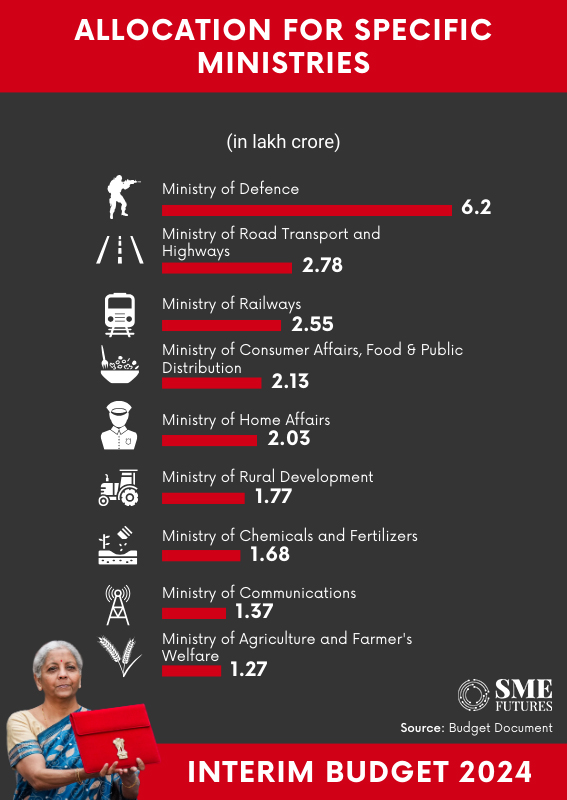
Rise in GST collections
The GST taxpayer base as well as monthly revenues have doubled since its launch. The monthly GST collection has crossed Rs 1.70 lakh crores in three months this fiscal, taking the average monthly mop-up to Rs 1.67 lakh crores in the current fiscal.
“GST collections are expected to grow about 11 per cent in 2024-25. If the monthly collection is Rs 1.67 lakh crores this fiscal, a growth of 11 per cent would be Rs 1.80-1.85 lakh crore monthly collections. This should be the new normal for GST collection in the next fiscal,” said Revenue Secretary Sanjay Malhotra to the media.
In the next fiscal, the budget has estimated GST collections at Rs 10.68 lakh crores, a 11.6 per cent growth over the Rs 9.57 lakh crore mop-up in 2023-24.
Allocation to major schemes
The government has increased the allocation for the Mahatma Gandhi National Rural Employment Guarantee Scheme (MGNREGA) to Rs 86,000 crores from Rs 60,000 crores in 2023-24. Similarly, Ayushman Bharat got an increment of Rs 300 crores making it a Rs 7500 crore programme for FY 2024-25.
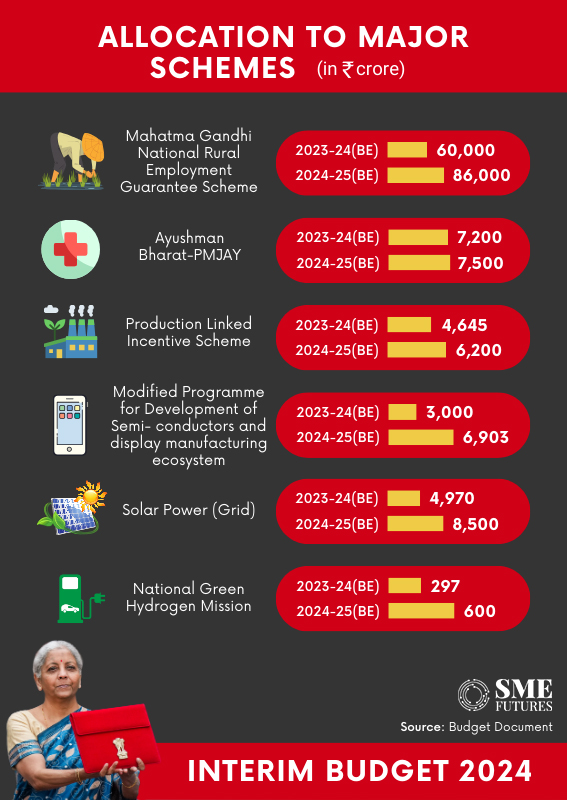
PLI scheme allocation has surged to Rs 6200 crores for FY 2024-25 from last year’s corpus of Rs 4645 crores. The solar power grid’s allocation saw an increment of Rs 3530 crores, making it a fund of Rs 8500 crores for 2024-25.
The National Green Hydrogen Mission’s allocation has been raised to Rs 600 crores from the current allocation of Rs 297 crores. The Modified Programme for Semiconductors and Display Manufacturing Ecosystem got a boost of Rs 3903 crores raising the corpus to Rs 6903 crores.
Overall, the interim budget for 2024 provides a comprehensive overview of the government’s fiscal priorities amidst the transition period. It focuses on bolstering key sectors while aiming to maintain economic stability. The budget emphasises targeted spending, prudent resource allocation, and a commitment to address evolving economic challenges, reflecting the government’s proactive approach towards making India a developed nation by 2047.

